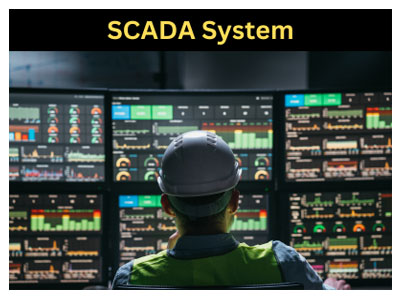Key Takeaway
SCADA (Supervisory Control and Data Acquisition) is neither a PLC (Programmable Logic Controller) nor a DCS (Distributed Control System). It is a system used for monitoring and controlling industrial processes across wide areas. SCADA collects real-time data from devices like PLCs and RTUs, displays it for operators, and allows remote control of processes.
A PLC is a hardware device designed for real-time control of specific machines or tasks. A DCS is used for centralized control of large, continuous processes within a single facility. While SCADA can work with both PLCs and DCS, it focuses on providing a centralized platform for monitoring and managing industrial operations. In short, SCADA is a monitoring system, while PLC and DCS handle the actual process control.
Understanding SCADA, PLC, and DCS as Distinct Systems
To grasp the difference between SCADA, PLC, and DCS, it’s important to define their unique roles in automation.
SCADA is a software-based system designed to monitor and control industrial processes. It collects data from field devices, processes it, and presents it in a user-friendly interface for operators. SCADA’s primary function is system-wide monitoring and decision support.
PLCs are hardware controllers that execute localized, real-time tasks. They process inputs from sensors, run pre-programmed logic, and trigger outputs to control devices like motors or valves.
DCS is a centralized system used for continuous process control within a facility. It integrates multiple controllers into a unified platform, managing variables like temperature, pressure, and flow.
While SCADA monitors and manages data, PLC and DCS focus on controlling processes. These systems complement each other, forming a cohesive automation framework.

The Role of SCADA in Industrial Automation
SCADA’s primary role is to provide operators with a comprehensive view of industrial operations. It excels in monitoring, data collection, and remote control.
A SCADA system collects data from devices like sensors, PLCs, and RTUs (Remote Terminal Units) across a facility or multiple sites. This data is processed and displayed in graphical interfaces, making it easier for operators to understand system performance. For example, SCADA might show temperature trends, machine statuses, or flow rates in real-time.
SCADA also enables remote control. Operators can adjust settings, start or stop machines, or respond to alarms without being physically present at the site. This is particularly useful in industries like power generation, water treatment, and oil pipelines, where assets are geographically dispersed.
By focusing on system-wide monitoring and remote accessibility, SCADA enhances operational efficiency and decision-making.
You May Like to Read
How PLCs Function Within a SCADA System
PLCs are integral to the functioning of SCADA systems, acting as the execution layer within the automation hierarchy.
In a SCADA setup, PLCs handle localized control tasks. For instance, in a manufacturing plant, a PLC might regulate the speed of a conveyor belt, maintain consistent product quality, or ensure safety by shutting down equipment during a fault. The PLC processes inputs from sensors and executes pre-programmed logic to manage outputs.
SCADA, in turn, collects data from the PLC and presents it to operators in an accessible format. This data might include machine statuses, alarms, or performance metrics. If an operator makes adjustments via the SCADA interface, these commands are sent to the PLC, which executes them in real-time.
This collaboration allows SCADA to focus on monitoring and decision support while PLCs ensure precision and reliability in control tasks. Together, they create a robust automation system that balances oversight with execution.
Comparing SCADA’s System-Wide Control to DCS
While SCADA and DCS share some similarities, they are designed for different scopes and applications.
1. Scope of Control:
SCADA is ideal for monitoring and controlling distributed systems, such as power grids or pipelines. It focuses on gathering data from remote locations and providing operators with centralized visibility.
DCS is used for controlling processes within a single facility, such as chemical plants or refineries, where precise and continuous control is critical.
2. Architecture:
SCADA uses a distributed architecture, integrating RTUs, PLCs, and communication networks to manage geographically dispersed assets.
DCS integrates multiple controllers into a unified platform, emphasizing centralized control within a localized area.
3. Application:
SCADA excels in applications requiring remote monitoring and data-driven decision-making.
DCS is better suited for continuous processes where redundancy, precision, and consistency are paramount.
While SCADA focuses on monitoring and remote control, DCS is built for centralized, process-specific control. Both are essential, depending on the industrial requirements.
The Relationship Between SCADA, PLC, and DCS
SCADA, PLC, and DCS work together to form a comprehensive automation ecosystem. Here’s how they interact:
1. SCADA and PLC:
PLCs act as the control layer within a SCADA system, executing tasks based on sensor inputs and operator commands. SCADA collects data from PLCs and provides operators with real-time insights and control capabilities.
2. SCADA and DCS:
While SCADA monitors system-wide performance, DCS focuses on localized process control. They can work together in complex setups, where SCADA provides oversight and DCS manages specific processes.
3. PLC and DCS:
PLCs can function independently or within a DCS. In a DCS, PLCs handle discrete tasks while the DCS oversees continuous processes, ensuring seamless integration and reliability.
These systems are not interchangeable but complementary, each addressing specific aspects of industrial automation.
Conclusion
SCADA is neither a PLC nor a DCS but a distinct system that works alongside both. While PLCs focus on localized, real-time control and DCS excels in centralized process management, SCADA provides system-wide monitoring and decision support. Together, they create a robust framework that enhances efficiency, reliability, and scalability in industrial automation.
Understanding how SCADA, PLC, and DCS interact is crucial for engineers and operators aiming to optimize operations and meet the demands of modern industries. By leveraging the strengths of each system, businesses can achieve seamless and effective automation.
